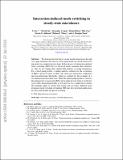| dc.contributor.author | Ge, Li | |
| dc.contributor.author | Cerjan, Alexander | |
| dc.contributor.author | Rotter, Stefan | |
| dc.contributor.author | Cao, Hui | |
| dc.contributor.author | Türeci, Hakan E. | |
| dc.contributor.author | Stone, A. Douglas | |
| dc.contributor.author | Liu, David | |
| dc.contributor.author | Johnson, Steven G | |
| dc.date.accessioned | 2017-06-23T13:46:30Z | |
| dc.date.available | 2017-06-23T13:46:30Z | |
| dc.date.issued | 2016-01 | |
| dc.identifier.issn | 1094-4087 | |
| dc.identifier.uri | http://hdl.handle.net/1721.1/110201 | |
| dc.description.abstract | We demonstrate that due to strong modal interactions through cross-gain saturation, the onset of a new lasing mode can switch off an existing mode via a negative power slope. In this process of interaction-induced mode switching (IMS) the two involved modes maintain their identities, i.e. they do not change their spatial field patterns or lasing frequencies. For a fixed pump profile, a simple analytic criterion for the occurrence of IMS is given in terms of their self- and cross-interaction coefficients and non-interacting thresholds, which is verified for the example of a two-dimensional microdisk laser. When the spatial pump profile is varied as the pump power is increased, IMS can be induced even when it would not occur with a fixed pump profile, as we show for two coupled laser cavities. Our findings apply to steady-state lasing and are hence different from dynamical mode switching or hopping. IMS may have potential applications in robust and flexible all-optical switching. | en_US |
| dc.description.sponsorship | United States. Air Force. Office of Scientific Research. Multidisciplinary University Research Initiative (Grant FA9550-09-1-0704) | en_US |
| dc.description.sponsorship | Massachusetts Institute of Technology. Institute for Soldier Nanotechnologies (Grant W911NF-07-D-0004) | en_US |
| dc.language.iso | en_US | |
| dc.publisher | Optical Society of America | en_US |
| dc.relation.isversionof | http://dx.doi.org/10.1364/oe.24.000041 | en_US |
| dc.rights | Creative Commons Attribution-Noncommercial-Share Alike | en_US |
| dc.rights.uri | http://creativecommons.org/licenses/by-nc-sa/4.0/ | en_US |
| dc.source | arXiv | en_US |
| dc.title | Interaction-induced mode switching in steady-state microlasers | en_US |
| dc.type | Article | en_US |
| dc.identifier.citation | Ge, Li et al. “Interaction-Induced Mode Switching in Steady-State Microlasers.” Optics Express 24.1 (2016): 41. | en_US |
| dc.contributor.department | Massachusetts Institute of Technology. Department of Mathematics | en_US |
| dc.contributor.department | Massachusetts Institute of Technology. Department of Physics | en_US |
| dc.contributor.mitauthor | Liu, David | |
| dc.contributor.mitauthor | Johnson, Steven G | |
| dc.relation.journal | Optics Express | en_US |
| dc.eprint.version | Author's final manuscript | en_US |
| dc.type.uri | http://purl.org/eprint/type/JournalArticle | en_US |
| eprint.status | http://purl.org/eprint/status/PeerReviewed | en_US |
| dspace.orderedauthors | Ge, Li; Liu, David; Cerjan, Alexander; Rotter, Stefan; Cao, Hui; Johnson, Steven G.; Türeci, Hakan E.; Stone, A. Douglas | en_US |
| dspace.embargo.terms | N | en_US |
| dc.identifier.orcid | https://orcid.org/0000-0001-7327-4967 | |
| mit.license | OPEN_ACCESS_POLICY | en_US |
| mit.metadata.status | Complete | |
